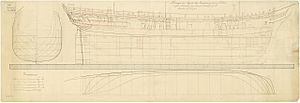HMS Providence (1791) facts for kids

Providence
|
|
Quick facts for kids History |
|
|---|---|
| Name | HMS Providence |
| Builder | Perry & Co, Blackwall Yard |
| Launched | 23 April 1791 |
| Acquired | February 1791 |
| Commissioned | April 1791 |
| Fate | Wrecked on 16 May 1797 |
| General characteristics | |
| Class and type | Sloop-of-war |
| Tons burthen | 406 (bm) |
| Length |
|
| Beam | 29 ft 1 in (8.9 m) |
| Draught |
|
| Depth of hold | 12 ft 3 in (3.73 m) |
| Sail plan | Full-rigged ship |
| Complement | 100 |
| Armament |
|
HMS Providence was a famous sloop (a type of small warship) of the Royal Navy. It is best known for its commander, William Bligh, who led a special voyage to collect breadfruit plants. This journey happened between 1791 and 1794.
The British Navy bought Providence in February 1791 while it was still being built. It was launched on April 23, 1791. Soon after, William Bligh became its captain. The ship was fitted with a special copper layer on its hull. This helped protect the ship from worms and barnacles in the ocean.
The Second Breadfruit Voyage
Providence set sail for the Pacific Ocean on August 2, 1791. This was Bligh's Second Breadfruit Voyage. His mission was to collect breadfruit trees and other plants. These plants were then taken to the West Indies. Many specimens were given to the Royal Botanic Gardens in St. Vincent. Providence returned to Britain in August 1793.
A young sailor named Matthew Flinders was a midshipman on this voyage. He was a teenager at the time. Later, as a captain, Flinders became very famous. He proved that Van Diemen’s Land (now Tasmania) was an island. He was also the first person to sail all the way around Australia. He was also the first to call the continent "Australia." This trip on Providence was his first time near Australia.
During the voyage, at Adventure Bay, Tasmania, a third lieutenant named George Tobin made an important drawing. It was the first European drawing of an echidna, a unique Australian animal.
Exploring with the Vancouver Expedition
After its breadfruit mission, Providence had some repairs done. In October 1793, it got a new commander, William Robert Broughton. He was ordered to join the Vancouver Expedition. This expedition was exploring and mapping parts of the world.
Providence left Britain on February 15, 1795. It sailed to Monterrey, but the Vancouver Expedition had already left. Broughton decided that Captain Vancouver would not have finished his mapping work. So, Broughton chose to sail and map the coast of East Asia instead.
During his explorations, Broughton named Caroline Island. He called it "Carolina" to honor the daughter of Sir Philip Stephens, 1st Baronet. Sir Philip worked for the British Admiralty, which managed the Royal Navy. This new name replaced an older one given by a Portuguese explorer.
Providence continued its journey to Asia. The crew mapped the coast of Hokkaidō near Muroran. They spent the winter of 1796 in Macau. While there, Broughton bought a small schooner. This small boat turned out to be very useful. On May 16, 1797, Providence was wrecked. It hit a coral reef near Miyako-jima, south of Okinawa. The ship's astronomer, John Crosley, wrote about the shipwreck in the ship's log book. Broughton and his crew used the schooner to continue their mission. They explored northeast Asia and returned home in February 1799.
See also
- European and American voyages of scientific exploration

